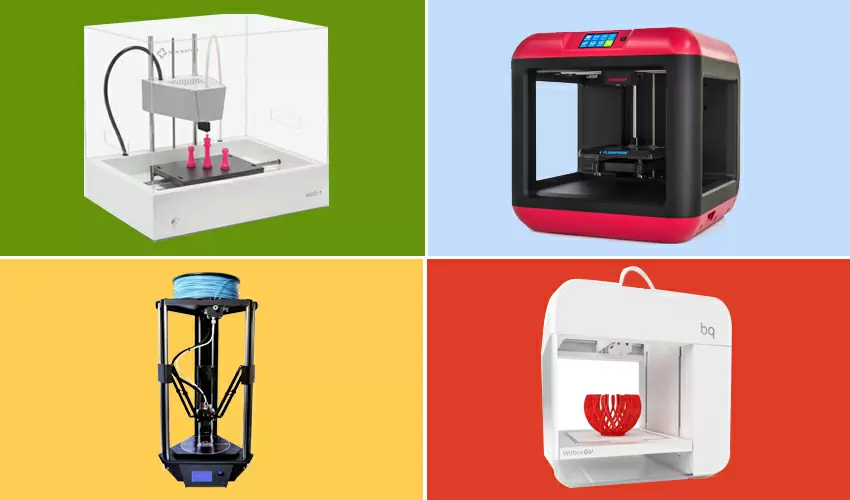3D printing has become more popular and widespread in the last couple of years. Today, both hobbyists and professionals can tap into the power of additive manufacturing to make simple prototypes and end-use parts for an array of purposes. If you’re thinking of getting into 3D printing, one of the first places to start is getting your own 3D printer. Here are 8 great considerations before getting a 3D printer.

1. Purpose
Before deciding on splashing out the cash, ask yourself, do I really need a 3D printer? If the answer is yes, the next consideration is the purpose and intended use of that device. Consider if your needs are for education, small business prototyping, hobby or industrial applications. The purpose of your 3D printer will flow right into our next point – technology.
2. Printing technology
Although the basic concept of 3D printing is universal, the printing technology differs significantly for application, capability, cost and output quality. The most common printing technologies in the industry are Fused deposition modelling (FDM) and Stereolithography (SLA). These two technologies do not only differ in their mode of operation, they differ in their material use, size capabilities, resolution and results. Other 3D printing technologies include Selective laser sintering (SLS) and Direct metal laser sintering (DMLS).
3. Cost
Depending on the end-use and printing technology, 3D printers can range anywhere between $200 to $10,000. There are custom DIY printers on the market within $200 to $600, while professional desktop 3D printers can vary from $1000 to $7000.
DIY printers are often suitable for basic applications with affordable resins, however, their output quality and range of customization is limited. With the professional desktop 3D printers, you can make functional prototypes and ready-to-use parts for your business. Industrial 3D printers that serve even broader uses with more features and customizations are available for around $8000 to $10,000.
4. Consumables
As is the case with any printer, once you procure the device, you have to cater for the recurrent consumable expenses. Depending on the type of printer you procure, the material cost may be higher or lower. FDM printers use filament spools which tend to be less expensive while SLA printers work with photo-curable liquid resins that more expensive.

Material and brand compatibility is also a key consideration before choosing your printer. Ask if your 3D printer can accept any brand of filament or whether you’re restricted to only in-house material, what filament diameter is required for the printer and the ease of processing of the material.
5. Build volume
Build volume refers to the capability and maximum sizes of parts that a 3D printer can make. The build volume also determines how many parts that can be printed at the same time on your 3D printer.
Generally, the bigger the printer, the higher the cost. After deciding on the application of your printer, quantify the standard size of your projects and determine what works best for you. Most standard desktop printers have a build dimension around 200 to 300mm across all sides, and 500 to 1000mm industrial options.
6. Print speed
Unlike CNC machining and injection molding, 3D printing and additive manufacturing is a relatively slow process. Most printers on the market are capable of extruding 50 to 150mm/s, however, the higher the quality and resolution of the print, the longer the print speed. When sourcing tor your 3D printer, consider the volume of work you will be doing, the number of layers, layer height and part accuracy. The higher the number of layers, the longer the print time. Additionally, consider parameters like heating rates, XY axes motion accuracy and extrusion rates to help you select product that is best suited for your requirements.
7. Accessories
There is an endless array of tech and gadget that can ease and improve your additive manufacturing process. At various price points, printers may differ in compatibility with accessories. Consider the compatibility of simple apparatuses like washing and post-curing fittings, external cameras and additional vents before choosing DIY, desktop or industrial 3D printer options.
8. Connectivity
Connectivity typically varies from printer to printer, but the three most popular options are microSD, USB and Wi-Fi technology. Most 3D printers will have at least one or a combination of two of these options.

The pros and cons of each method is explained. USB/Wired connectivity requires the computer to remain powered all through the process, but allows for more visibility and control over the process.

Wi-Fi/Wireless 3D printing can be achieved with cloud technology, but internet connectivity must be ever-present and strong enough. With microSD cards, you may not be able to monitor your printing process, however, your computer resources are not occupied, and you don’t need to stay hooked to the printer.

Firstpart 3D Printing Services
Don’t own or can’t get a 3D printer? Come to Firstpart! If you’re looking to make high-quality 3D printed prototypes for a wide variety of applications. Firstpart is your one-stop-shop outsource manufacturers in China. Our industrial 3D printers are capable of making 3D parts with complex geometries at cost-effective rates. We also offer multiple post-printing solutions to help finish your parts, while our other manufacturing solutions like Plastic injection molding and CNC machine service is readily available to help upscale your project to mass production.










